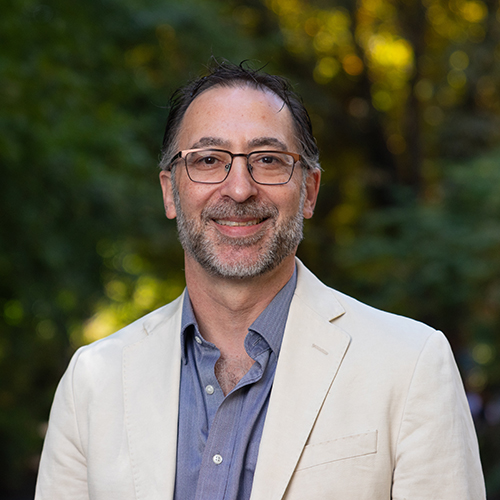Last year, ISIS members smashed ancient sculptures at the Mosul Museum in Iraq — and proudly captured the destruction on video. In Syria, archaeological sites are being looted on a regular basis. Across the Middle East, bulldozers have destroyed sites dating back thousands of years. Why is this happening? And what can be done to stop it?
Archaeologist Stephanie Selover, a UW assistant professor of Near Eastern languages and civilization, tackles these and other questions in a new undergraduate course, NEAR E 312: Looting and Loss: The Recent Destruction of Cultural Heritage Sites in the Middle East. The course covers the “why” of looting and seeks strategies for addressing the problem.

Cultural looting has surged in recent years, but the phenomenon is nothing new. “What’s happening today is monstrous, but it’s not unique. Humans have done this over and over again,” explains Selover, who devotes several class sessions to ancient Mesopotamia and the Roman Empire to make her point. “When the Romans came to Carthage, they killed an entire civilization in the course of three years. What’s different now is that we can see the destruction as it is happening, which makes it really visceral.”
Having worked on excavations in Syria, Selover finds recent acts of vandalism there particularly distressing. “All of us archaeologists who have worked there watch what’s happening in absolute horror,” she says. “Seeing everything destroyed has been heartbreaking. It’s real for me. It’s not just academic.”
Selover devotes a full class session to what’s happening in Syria, but she gives equal time to Iraq and Egypt because “what these countries stand for, what their archaeology means to them, and how they see their history and their museums is different for each.” The common ingredient? Political upheaval, which is usually a precursor to looting.

In Iraq, looting was nonexistent during Saddam Hussein’s reign. Hussein saw modern Iraq as the true descendant of Mesopotamia and Babylon and strongly supported archaeologists’ efforts to uncover and preserve that history. But when Hussein’s opponents gained power, they attacked what he cared about, including archaeological sites that he’d used to promote his secular concept of nationalism. Acts of ideological vandalism soon led to subsistence looting — poor individuals digging for artifacts to sell — as well as looting by organized mafias who use bulldozers to scoop up artifacts, using the profits to purchase weapons.
“There are lots of reasons why people loot,” says Selover. “You can’t just demonize all of them. Yes, there are mafias that come in with bulldozers, but there are also poor farmers who are starving because their land has dried up and they need to feed their children. This happens everywhere when the state breaks down. People start finding ways to make money, and if you have a lot of cultural material, that’s what you do.”
Whatever the looter’s motivation, once an artifact is dug up and sold, the damage has been done. Any information the artifact might have provided is lost without a record of where it was found, objects found nearby, and other details. “Context matters,” says Selover. “Without that information, all that’s left is a pretty pot to sell on eBay.”
Seeing everything destroyed has been heartbreaking. It’s real for me. It’s not just academic.
Selover’s class explores not only the problem but potential solutions. Students come at the topic from diverse backgrounds, often leading to spirited discussions about thorny ethical issues. Should the U.S. military in Baghdad have intervened when the Baghdad Museum was raided in 2003? Should subsistence looters be encouraged to record data about the artifacts they loot — essentially making them amateur archaeologists — even if they then sell the artifacts illegally? Would looting be better addressed by focusing on poverty reduction? Should artifacts not be repatriated to countries that are politically unstable?
David Stults, a senior majoring in political science and comparative religion, appreciates the opportunity to dive into difficult questions. “The class is at the very end of the day, at a terrible time, but it’s the class I look forward to all week,” says Stults, whose interest in the Middle East dates back to his time as a Marine serving in Iraq and Afghanistan. “In a lot of classes, professors tell you about a problem that’s too late to fix. But [Professor Selover] helps us remember that what the Islamic State is doing is not the first time, and there will be others that do something similar later. So the question becomes, what can we do to fix this in the future? We bounce ideas back and forth in class and everyone comes alive.”

Crystal Donovan, a history major, arrived at the course with a long interest in heritage preservation. “I care about the destruction and looting of ancient sites because I care about people, about human stories going back thousands of years, and about modern refugees and civilians who just want to survive and take care of their families,” says Donovan.
The course material can be depressing, but Donovan also finds it motivating. “I feel I am collecting tools with which I can, in some small part, help fix the problems,” she says. “It’s often painful, but things don’t improve by turning away.”
More Stories

Need a break from holiday movies? Try these
For those wanting a break from holiday movies, Cinema & Media Studies faculty and grad students offer suggestions.

A "gesture" to jump-start careers
To prepare students for professional success, the UW College of Arts and Sciences offers “gesture,” a mock startup company where student interns gain skills that employers seek.

The Curious Journey of Chinese Characters
Several Asian countries adapted the Chinese writing system—the oldest writing system still in use—for their own languages. In a new book, Professor Zev Handel shares how that happened.